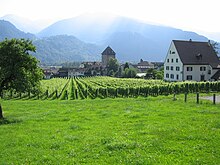Maienfeld
Maienfeld (Romansh: Maiavilla) is a municipality in the Landquart Region in the Swiss canton of Graubünden.
Prehistoric Bronze work and a pre-Roman cellar have been found in the city and on St. Luzisteig hill.
[4] The 4th or 5th century Tabula Peutingeriana map shows a place called Magia near modern Maienfeld.
The name of the village changed several times over the following centuries and included; Magenza, Lopine, Maging and Magen zu Luppinis.
Their castle at Maienfeld was destroyed in 1079 by Henry IV, HRE during the Investiture Controversy.
The current Schloss Brandis was initially built in 1270–75 by the von den Aspermont family and later by Friedrich VII, count of Toggenburg.
In 1388, Maienfeld acquired the right to charge a toll on the Roman Road that led from Chur over the St. Luzisteig to the north.
Following the death of the Toggenburger line, Maienfeld joined the League of the Ten Jurisdictions in 1436.
During the 1499 Swabian War, Maienfeld was forced to open its gates to the invading Austrian army.
In 1529, the Tardis bridge was built over the Rhine river, shifting trade routes away from Maienfeld.
Maienfeld is located 8 kilometers (5.0 mi) southeast of Sargans in the lower Chur Rhein valley.
To the north, it is bordered by Balzers, Triesen, Schaan, the country of Liechtenstein, Nenzing and Vorarlberg, Austria.
Maienfeld is located on the right side of the Rhein valley and includes the boroughs of; Bovel, Rofels und St. Luzisteig.
St. Luzisteig is the site of an important alpine pass, which leads into Liechtenstein, and is guarded by an 18th-century fortress that is now barracks for the Swiss Army.
The old Walser settlement Stürfis was abandoned by 1633 and became a part of Maienfeld, when the inhabitants moved to Rofels.
In contrast, the Walser settlement Guscha was occupied until 1969 when the last two families were bought out by the Swiss Army and the village became part of their training area.
The highest point in the city boundaries is the Hinterer Grauspitz mountain, which is 2,574 m (8,445 ft) high.
[14] The historical population is given in the following chart:[15] Johanna Spyri's classic book Heidi is largely set in Maienfeld.
[22] From the 2000 census[update], 689 or 29.1% are Roman Catholic, while 1,384 or 58.4% belonged to the Swiss Reformed Church.





